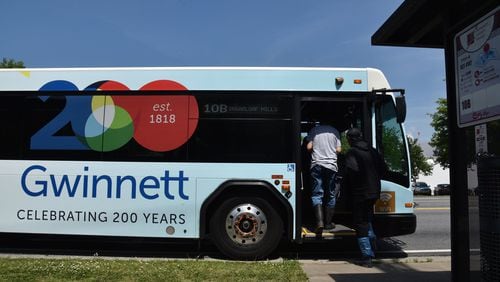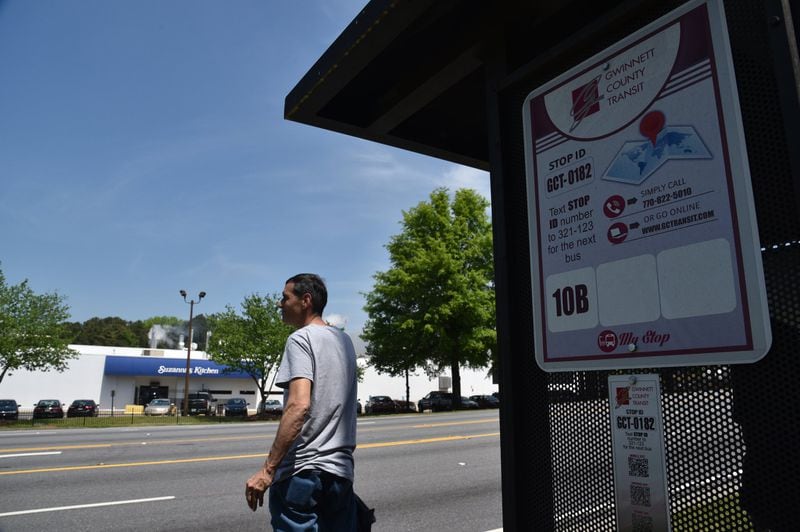Editor’s note: This article was originally published on May 3, 2018. Since then, Gwinnett County has reached a pending agreement with MARTA and called a March 19 referendum to give voters the chance to decide if they want to join the transit system and pay a new 1 percent sales tax to fund transit improvements.
Read more about the referendum with The AJC's comprehensive voter's guide. And enjoy the story.
The good news: Lauren Dixon had a job interview.
The tricky part: It was at the Cobb Galleria, some 25 miles from the single mother’s current home at Rainbow Village, a Gwinnett County nonprofit that provides housing and other assistance to families in need.
Thankfully, Dixon was able to find a babysitter and a ride to the closest MARTA station in Doraville that morning. From there, she took a train to the Arts Center station in Atlanta, then caught a CobbLinc bus to take her where she needed to go.
As the conversation around transit expansion in metro Atlanta has played out in recent months — culminating in the passage of legislation that could pave the way for dramatic changes in the city's suburbs and beyond — much of the focus has been on relieving traffic congestion. It's a noble cause. Population growth doesn't appear to be slowing down and, according to one recent study, there are more than 100,000 metro Atlantans whose daily commutes are more than 90 minutes.
But Atlanta’s suburbs are no longer havens for the middle and upper classes. More poverty-level or lower-income families like Dixon’s now reside in places like Gwinnett and Cobb and north Fulton counties, key suburban areas in the new transit expansion push. For those families, accessible and reliable transportation can serve not only as a convenience but as a lifeline.
Without it, “You don’t have access to jobs, you’re less likely to get employed, get educated, get a high-income job,” said Junfeng Jiao, an assistant professor at the University of Texas at Austin and the founding director of its Urban Information Lab. “Basically, for that individual, it’s a downward spiral.”
Jiao is credited with coining the phrase “transit desert” to describe a place where the demand for transit solutions far exceeds the supply, and he has studied the ramifications of such situations extensively.
“We have to pay attention to it,” he said. “Otherwise it’s going to come back and bite us.”
‘A hugely disadvantageous position’
After a three-hour journey, Dixon arrived for her interview half an hour early.
“It’s always a struggle,” she said. “… My whole day revolves around trying to figure out which places I can get to.”
As long as Dixon’s commute to her interview was, it could’ve been worse. Her final destination just happened to be on the bus line, and the kindness of a friend helped her avoid her usual 45-minute walk to the closest Gwinnett County Transit bus stop in order to get to Doraville.
Dixon, who landed at Rainbow Village with her young daughter after a series of bad breaks, currently has a job she can walk to. But she said she’s had to turn down other, better-paying positions because they required frequent travel — not around the country but within the county.
Gwinnett currently has just six local bus routes.
“You have to make decisions on what’s more important for the day,” Dixon said. “Is it more important taking my daughter to the doctor, or is it more important that I get to work?”
She’s hardly the only one faced with such decisions each day.
A recent study from the Joint Center on Housing Studies at Harvard University found that the number of high poverty neighborhoods is increasing in suburban areas across the country. And nowhere is that number rising faster than Atlanta.
In 2000, there were 102 “high-poverty” neighborhoods — defined as areas where 20 percent or more of the population was below the poverty line — in metro Atlanta, according to the study.
By 2015, that number had nearly tripled to 304. More than three-fourths of those households were in suburban areas.
The latest American Community Survey data estimates that about 13 percent of Gwinnett County’s 920,000 residents — or nearly 120,000 people — live below the poverty line. About 12 percent of Cobb County’s 688,000 residents — or nearly 80,000 individuals — live below the poverty line.
Data compiled by the Atlanta Regional Commission suggests those numbers are growing, and that the number of households without vehicles is too. Maps created by the ARC for The Atlanta Journal-Constitution show significant pockets of both along I-85 in Gwinnett, in south and central Cobb County and along Ga. 400 in north Fulton County.
More transportation options for those populations could be life-changing, Jiao said.
“If you don’t have mobility access, you’re at a hugely disadvantageous position in society,” he said.
Matthew Elder, the executive director of Gwinnett nonprofit Family Promise, put it another way.
Family Promise operates the county’s only true emergency shelter, a facility inside a church that happens to be near a Gwinnett County Transit bus line. But if folks can’t get to a bus on the other end, they can’t get to the shelter to get help.
“Transit,” Elder said, “is opportunity.”
‘Who’s already here’
State Rep. Kevin Tanner is the Republican from Dawsonville who authored the legislation that, once signed by Gov. Nathan Deal, will authorize 13 suburban counties to hold referendums asking voters if they want to opt-in on a 30-year, transit-funding sales taxes.
He told The Atlanta Journal-Constitution recently that increasing mobility for low-income folks, or just those without cars, was indeed a consideration in the push for transit reform. In fact, his focus extends even to Atlanta’s farthest flung suburbs — the regional transit commission formed by Tanner’s legislation includes counties like Fayette and Coweta.
Many of those won’t be voting in favor of extensive transit plans anytime soon. And those counties that have expressed interest — or need — are in various stages of the process.
In Fulton, county commissioners and local mayors are still deciding when to have a referendum on adding bus rapid transit lines (which function similarly to light rail, but without the rail) on Ga. 400 and South Fulton Parkway. In Cobb, officials are considering the creation of a special district that would allow transit expansion.
In Gwinnett, officials are wrapping up a comprehensive transit plan that includes proposals for a few miles of heavy rail, several bus rapid transit lines and greatly expanding local bus service, among other offerings. A referendum is possible this fall.
Though Dixon knows it will be years before any significant transit expansion is actually put in place, she’s glad that the ball may be rolling and that there seems to be a consensus that something needs to be done.
But she also wants folks to know that all of it is about more than relieving traffic congestion for those commuting to and from Gwinnett, and for the population boom that’s coming.
Sometimes, she said, “it’s about who’s already here and trying to get around.”









